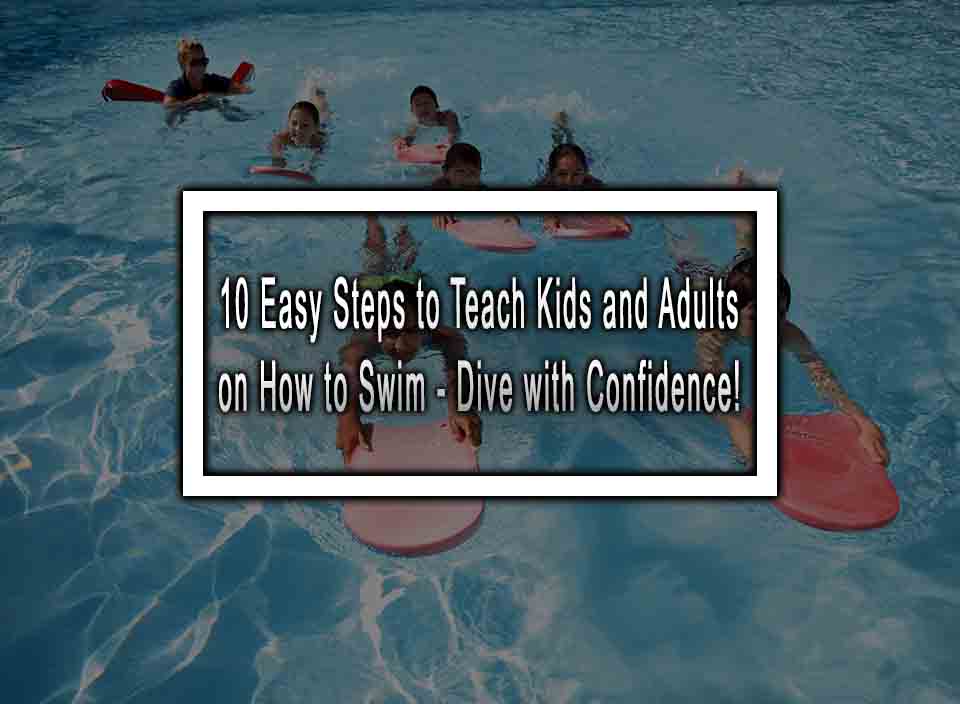Table of Contents
ToggleDive in and Make a Splash: Learn How to Swim with These Steps!
Did you know that swimming is not only a great way to cool off on a hot summer day but also a crucial life skill that can save lives? Whether you’re a kid or an adult, learning how to swim opens up a whole new world of fun and adventure in the water. If you’re ready to take the plunge, we’ve got you covered with these 10 simple steps to teach both kids and adults how to swim like a pro!
1.Gear Up for Success: Essential Swimming Equipment for Beginners
Before diving into the water, it’s essential to have the right swimming gear. Make sure to invest in a comfortable swimsuit or swim trunks that will allow freedom of movement. Goggles are another must-have item, as they protect the eyes from pool chemicals and enhance visibility underwater. Additionally, flotation devices like arm bands or floaties can be helpful for beginners, providing extra confidence and support.
2. Picking the Right Spot: Finding the Ideal Swimming Pool for Beginners
Finding the right swimming pool is crucial for beginners to ensure a safe and pleasant learning experience. Look for a pool that offers shallow areas as well as a designated area for learning and practicing swimming skills. Also, consider pools with lifeguards on duty and well-maintained facilities. Remember, a comfortable and well-suited swimming environment can make a huge difference in the learning process!
3. Stretch and Flex: Prep Your Body for Swimming Success
Just like any other physical activity, swimming requires proper warm-up exercises to prevent injuries and enhance performance. Encourage kids and adults to engage in simple stretching exercises that focus on the arms, legs, and core muscles. This will help improve flexibility, increase blood circulation, and prepare the body for an enjoyable swimming session.
4. Dive into Confidence: Building Trust in the Water
Building water confidence is a fundamental step in learning how to swim. For beginners, start with activities that familiarize them with the water, such as getting comfortable with water splashing on the face, blowing bubbles underwater, and floating on the back with assistance. These fun activities not only build trust in the water but also introduce them to basic swimming movements.
5. Float like a Pro: Mastering the Art of Buoyancy
Floating is an essential skill that serves as the foundation of swimming. Teach kids and adults how to position their bodies in a relaxed and buoyant state by lying on their backs, spreading their arms and legs slightly, and focusing on controlling their breathing. Practicing floating techniques in shallow water first will boost their confidence and pave the way for mastering more advanced swimming strokes.
6. Safety First: Crucial Water Safety Tips for Swimmers
Safety should always be the top priority when in the water. Teach kids and adults essential water safety tips, such as never swimming alone, always keeping an eye on the lifeguard, and understanding the meaning of pool signs and signals. Additionally, educate them on the dangers of diving in shallow water and the importance of staying within designated swimming areas at all times.
7. Paddling Fun: Mastering the Doggy Paddle
The doggy paddle is a beginner-friendly swimming stroke that introduces the concept of coordinated arm and leg movements. Show kids and adults how to perform the doggy paddle correctly, focusing on alternating their arms and kicking their legs in a paddling motion. Start by practicing this stroke in shallow water, gradually progressing to deeper areas as their confidence and skills improve.
8. Freestyle Freedom: Embracing the Popular Swimming Stroke
Once comfortable with the doggy paddle, it’s time to level up and introduce the most popular swimming stroke: freestyle. Teach kids and adults the correct arm movements, emphasizing the importance of proper breathing techniques. Encourage them to practice in a straight line across the pool, gradually increasing the distance as they gain more endurance and confidence in their swimming abilities.
9. Backstroke Bliss: Discovering the Beauty of Backward Swimming
Backstroke is a graceful swimming stroke that helps build overall body strength and improves coordination in the water. Teach kids and adults how to perform the backstroke correctly, focusing on arm movements and maintaining a steady kick. It’s important to remind them to periodically check their position relative to the pool’s edges to avoid collisions!
10. Delving into Advanced Strokes: Butterfly and Breaststroke Mastery
Once comfortable with freestyle and backstroke, adventurous swimmers can explore more advanced strokes like the butterfly and breaststroke. These strokes require more coordination and strength but offer a rewarding challenge. Encourage kids and adults to practice these strokes under the guidance of a qualified swimming instructor, as they can provide valuable feedback and help ensure proper technique.
Dive into a Lifetime of Fun: Unleash the Swimmer Within!
Learning how to swim is a skill that brings a lifetime of joy, safety, and confidence in the water. By following these 10 easy steps, kids and adults can overcome any fears and dive into a world of fun aquatic adventures. Remember to always prioritize safety, practice regularly, and seek guidance from qualified swimming instructors when needed. So grab your swimsuit, put on your goggles, and let’s embark on an exciting journey to become confident swimmers, ready to make a splash wherever we go!
Steps to Teach Kids and Adults How to Swim FAQ
Here are the most common questions about steps to teach kids and adults how to swim.
1. What age should kids start learning to swim?
It is recommended that kids start learning to swim around the age of 4 or 5. However, some children may be ready to start earlier, while others may need more time before beginning formal swimming lessons.
2. How do I choose the right swimming instructor?
When choosing a swimming instructor, look for someone who has experience teaching children or adults how to swim. It is also important to find someone who is patient, encouraging, and able to effectively communicate swimming instructions.
3. How many lessons does it take to learn how to swim?
The number of lessons required to learn how to swim can vary depending on the individual’s comfort level in the water and natural ability. Typically, it may take around 10-20 lessons for children and adults to become comfortable and proficient swimmers.
4. Can adults learn to swim if they have never learned before?
Yes, adults can learn to swim at any age. It may take longer for adults to overcome any fear or apprehension associated with water, but with patience and practice, they can become proficient swimmers. It is important to find a supportive instructor who is experienced in teaching adults.












